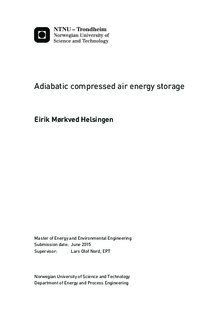Adiabatic compressed air energy storage
Master thesis
Permanent lenke
http://hdl.handle.net/11250/2350057Utgivelsesdato
2015Metadata
Vis full innførselSamlinger
Sammendrag
An increasing amount of intermittent renewable energy sources are being introduced to the European electrical grid. This results in difficulties to maintain and ensure a reliable and steady electricity supply. Energy storage can be used to balance the fluctuations caused by the renewable electricity sources, and thus allow the electricity generation to follow demand. As of today there are two facilities for compressed air energy storage (CAES) in the world, one in Huntorf (Germany) and one in McIntosh (USA). These power plants are diabatic and require supply of fuel. An alternative to diabatic CAES can be adiabatic storage where the need of fuel falls away.The main objective of this thesis is to model and simulate an adiabatic CAES cycle in order to calculate and analyse the round-trip efficiency. The purpose is to assess whether an adiabatic configuration can be a good option for energy storage.The adiabatic model was built and simulated using the process-modelling program EBSILON Professional. It was simulated over a full cycle consisting of; 7.8 hours charging period with constant power, 12 hours storage and 2.3 hours with constant power generation. The model was simulated using both real and ideal component values. Effects of changing compressor and gas efficiencies were investigated, and a sensitivity analysis was performed. The adiabatic model was also compared with two reference models, based on the existing diabatic power plants.The calculated round-trip efficiency for the real configuration was 55.4 %. Using the ideal configuration the efficiency reached as high as 71.2 %, which corresponds well with the values known from the literature. For the real configuration caused a 3 % change in compressor and gas turbine efficiency a 5 % change in round-trip efficiency. The sensitivity analysis showed that gas turbine and compressor operation at powers different than design had strong impact on the round-trip efficiency. Ambient air temperature, thermal storage tank temperature and intercooler outlet temperatures also made considerable changes to the round-trip efficiency. The efficiencies calculated for the diabatic CAES reference models were 44 % for the Huntorf model and 51.3 % for the McIntosh model. These values are close to the real power plant efficiencies of 42 % and 54 % respectfully. The most important result from this work is the adiabatic CAES model round-trip efficiency of 55.4 %. This is of the same magnitude as the real McIntosh power plant efficiency. For an adiabatic CAES power plant is there however no fuel consumption and accordingly no cost of fuel or greenhouse gas emissions. It is therefore believed that the simulated adiabatic CAES model could be a viable option for energy storage in a future intermittent electrical system.
